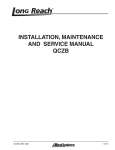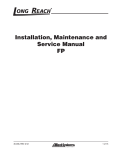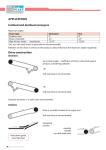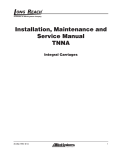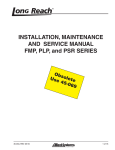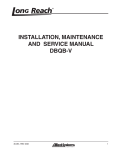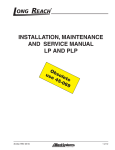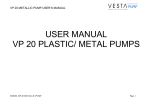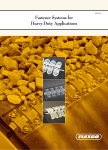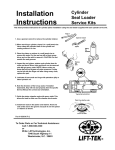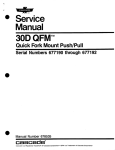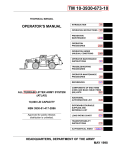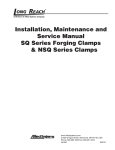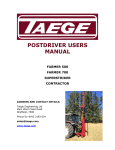Download MAINTENANCE AND SERVICE MANUAL PHA
Transcript
MAINTENANCE AND SERVICE MANUAL PHA 45-046, REV. 3/08 1 TABLE OF CONTENTS SECTION PAGE SECTION PAGE 1 MODEL IDENTIFICATION ..............3 3 SERVICE PROCEDURE 2 SAFETY SUMMARY 2.1 2.2 2.3 2.4 GENERAL INFORMATION....................... 4 LOAD HANDLING................................... 5 LOAD POSITIONING............................... 5 OPERATION CONTROLS.........................6 3.1 3.2 3.3 3.4 3.5 3.6 ATTACHMENT REMOVAL........................7 CYLINDER REMOVAL............................. 7 CYLINDER INSTALLATION.......................7 CYLINDER DISASSEMBLY....................... 7 CYLINDER INSPECTION..........................8 CYLINDER ASSEMBLY............................ 9 4 MAINTENANCE 4.1 4.2 4.3 MAINTENANCE SCHEDULE.....................10 TORQUE SPECIFICATIONS.....................10 LUBRICATION...........................................11 2 45-046, REV. 3/08 SECTION 1 MODEL IDENTIFICATION Each clamp is identified by a model number and a serial number located on the attachment nameplate which is attached to the top of the unit prior to shipment. Before ordering replacement parts for any unit, be sure to use the correct parts list for your model number. Both model number and serial number must be given to ensure that the correct parts are ordered. NOTE: The serial number is also metal stamped onto the plate under the identification plate. PH A Class II Mounting Date Received: - 45-046, REV. 3/08 - Perry Hook 3 SECTION 2 SAFETY SUMMARY 2.1 General Information Safety is Everyone’s Responsibility Whether you are new on the job or a seasoned veteran, these safety tips may prevent injury to you, to others, or to the materials you are handling. Always be alert, watch out for others, and follow these suggestions: Attachments Handle Material - Not People. Safety starts with common sense. GOOD JUDGEMENT, PROPERLY MAINTAINED EQUIPMENT, CAREFUL OPERATION, AND PROPERLY TRAINED OPERATORS. 1. Check your equipment before you operate it. 2. Check to make sure the attachment on your truck is the same as on the truck capacity plate. 3. Check for hydraulic leaks and cracked hoses or fittings. Figure 2-1 9. Never use the attachment or its load to support a man carrying device. 10. Never position an attachment or load over people. (Figure 2-2) 4. Check the hydraulic oil level in the lift truck hydraulic reservoir. 5. Check for physical damage to the attachment. If anything looks wrong, unusual or different, report it before using the attachment. 6. When removing / installing dismountable attachments always keep hands and feet free from dangerous positions or pinch points. Never leave a dismounted attachment in a dangerous position. 7. Check to make sure that the dismountable attachment is properly secured to the truck carriage before using the lift truck and attachment. 8. Never stand on top of material being raised, lowered, or transported. (Figure 2-1) 4 Figure 2-2 11. Never leave an attachment or load in an elevated position. 12. Never reach through the mast of the truck. Keep all parts of the body within the driver’s compartment. 13. Never leave a lift truck unattended without lowering the load to the floor, setting the brake, and turning the truck off. 45-046, REV. 3/08 14. Always operate an attachment from the operator’s seat, never while standing next to the lift truck. 15. Never stand in front of or beside an attachment that is being operated. Never allow another person to approach an attachment that is being operated. (Figure 2-3) 16. Do not allow riders on the truck at any time. fects the stability and steering of the lift truck. 6. Do not use an attachment to open or close boxcar doors. Doing so can severely damage the attachment and cause loss of warranty. Damage to clamp arms may result in product damage. 7. Do not carry loose items or unsupported loads on top of a clamped load. 8. Never allow anyone under a load or under the carriage. 9. Never use chains, cables, or other devices in conjunction with an attachment for load handling. 10. Never clamp loads other than what the attachment was designed to handle. Figure 2-3 17. Always use reverse when carrying a load that impedes full vision. 18. Watch for pedestrians when transporting. Sudden stops can dislodge all or part of a load. 11. Travel slowly around corners. Sound horn on blind corners. Be careful of tail swing and overhead clearances. Watch in all directions. Avoid sudden stops. 12. Do not exceed the specified maximum operating pressure or flow for the attachment. To do so can severely damage the attachment and cause loss of warranty. 2.2 Load Handling 1. All operators must be trained and qualified. 2. Never overload the attachment. Refer to the attachment nameplate for the rated capacity of the attachment. Refer to the nameplate of the truck for the net working capacity of the truck and attachment. Observe the lower of the two capacities. The attachment capacity is the structural rating of the attachment and should not be exceeded. Net working capacity is the truck manufacturer’s rating of the truck/ attachment combination. 3. Never use a load to support or move another object. Doing so can easily exceed the holding capacity of the attachment, causing loss of the load. 4. Never lift, lower, side shift, pivot, rotate, or tilt loads while traveling. Repositioning loads while traveling affects the stability of the truck and may impede vision or clearances. 2.3 Load Positioning 1. Always operate an attachment from the driver’s seat. 2. Always lower the attachment if you need to leave the lift truck. Remember a lift truck supporting a load requires your full attention. 3. Never use the attachment or its load to support or move other loads or equipment. 4. Always carry loads as close to the floor as possible, consistent with the surface being traversed. Scraping or bumping the floor surface with the load or the attachment can severely damage the attachment and cause product damage. The mast should be tilted back. 5. Never speed or race a lift truck. High speed adversely af- 45-046, REV. 3/08 5 5. Always keep the load positioned as close as possible to the horizontal center of the lift truck. 6. Always back down ramps or inclines. Driving forward down a ramp or incline with a clamped load will lessen the stability of the truck. (Figure 2-4) 2.4 Operator’s Controls 1. For clarity, the direction of arm movement is shown on the control handle. To move the arms in the direction shown, pull the handle towards the operator. To move the arms in the opposite direction, the push the handle away from the operator. Clamp Fork Positioner Figure 2-4 7. Do not cross dock boards or dock levelers with the attachment or carriage fully lowered. Ramming the front or rear of the attachment against a dock board can cause severe damage. 8. Always check loads to be handled. If they are broken, unbalanced, loose, or too heavy, advise a supervisor or properly correct the situation prior to handling. 9. Limit lift truck movement to a minimum when high stacking. Limit sideshift movement to a minimum when high stacking. 10. Always be observant when high stacking. Look for poorly stacked loads, overhead obstacles, broken cartons, or damaged products in the stack. Push / Pull Rotate Side Shift Figure 2-5 Note: OSHA or state regulations may require the installation of backrests. We suggest that you check your application against those requirements. 11. Always carry cylindrically shaped loads in the vertical position, not the horizontal. 12. Always clamp loads with the contact pads, if applicable, not the arm or arm base. 13. Never rotate a load that is off center to the centerline of rotation. Severe damage to the rotator could result. 14. Always check the attachment for proper fit and engagement of the truck carriage. 6 45-046, REV. 3/08 SECTION 3 SERVICE PROCEDURE 3.1 Attachment Removal 3.3 Cylinder Installation 1. Position the attachment forks to the width of the unit’s body. 1. Install the clevis pin and hair pin into the base end of the cylinder. 2. Attach the hydraulic connections to the cylinder. before disconnecting any hydraulic connections be sure to turn off the trucks power and activate the trucks hydraulic functions in both directions to bleed off the hydraulic pressure. 3. Extend the cylinder until the rod end hole lines up with the mounting hole. Install the clevis pin and hair pin into the rod end of the cylinder. 4. Turn on the trucks power and activate the positioning cylinders several times to bleed out trapped air. 2. Disconnect the hydraulic connection for the attachment positioning at the side shift cylinder. 3. Slightly raise the truck carriage to allow the removal of the lower retainer hooks. when hydraulic service has been performed, before returning attachment to service be sure to activate the hydraulic functions several times to bleed out trapped air in the system. 4. Position the attachment on the edge of a pallet. Lower the attachment so that the lower carriage bar misses the pallet when lowered. Tilt the mast forward to allow the carriage to disengage from the upper mounting hooks and back away. If lowering onto a floor, blocks of wood can be place under the body of the attachment to raise the rear. 3.4 Cylinder Disassembly 5. To reinstall, follow the installation procedure in this manual. 2. Clamp the cylinder lightly at the base end in a soft jawed vise. Use a block or other support under the rod end of the cylinder. (Figure 3-1) 1. Remove the cylinder from the attachment. See removal instructions. when hydraulic servicing has been performed, before returning attachment to service be sure to activate the hydraulic functions several times to bleed out trapped air in the system. 3.2 Cylinder Removal 1. Disconnect the hydraulic connections. 2. Remove the cylinder rod end hair pin and clevis pin. Figure 3-1, Cylinder Vise 3. Remove hair pin and clevis pin at the base end of the cylinder. 45-046, REV. 3/08 7 3. Spread and remove the retaining ring from the gland cap. 4. Push gland inward 1 inch and pry out lock ring. 8. Carefully pry up on the piston seals using a blunt tip screw driver being careful not to scratch the seal grooves. Cut the seals to remove from the piston. (Figure 3-4) 5. Remove the rod assembly from the cylinder tube. 6. Clamp the rod assembly in a soft jawed vise on the wrench flats, not on the rod surface. A If the rod does not have wrench flats use two pieces of wood on both sides of the rod to prevent scaring. (Figure 3-2) Figure 3-4, Piston Seal 9. Use the same procedure as above to remove the seals from the gland cap. 3.5 Cylinder Inspection Inspect the cylinder tube bore for: 1. Deep scratches or nicks. 2. Signs of galling or excessive wear. 3. Out-of-roundness or deformities of the barrel. Inspect the Piston for: 1. Scratches or nicks on seal grooves. 2. Wear on O.D. Figure 3-2, Cylinder Shaft 7. Remove the piston retaining nut and remove the piston. (Figure 3-3) Inspect the Cylinder Rod for: 1. Scratches or nicks on the rod surface. 2. Straightness of the rod. 3. Damaged threads. Inspect the Gland Cap for: 1. Scratches or nicks in seal grooves. 2. Damaged threads or spanner wrench holes. 3. Excessive wear in bore. Replace any component found to be bad. Retaining Ring Lock Ring Gland Cap Piston Nut Piston Figure 3-3, Rod Assembly 8 45-046, REV. 3/08 3.6 Cylinder Assembly 1. Spray the Piston, Gland Cap, and Seals with WD40 or other similar product to ease slipping of the seals in place. 2. Note the direction of the seal on the piston. Improper installation will result in poor performance. The cupped side or O-Ring side of the seal should be facing the gland cap. (Figure 3-5) Piston Seal Piston Nut O-Ring Cylinder Rod 4. Install the gland cap on the cylinder rod being extremely careful not to cut the rod seal on the threads of the rod or rod shoulder. If available use a sleeve to cover the rod threads or plastic electrical tape. 5. Install the piston on the rod and tighten the locknut to 90 ft-lbs (0.56 UNF), 22 ft-lbs (0.75 UNF). 6. Spray the inside of the cylinder tube with lubricant to Seal ease inserting the rod and piston. Insert the rod and piston into the cylinder tube. Tap the rod rub- Ring Backup Ring in with a Lock ber mallet if resistance is encountered. O-Ring Retaining Capand spread retaining ring to 7. Press on theGland lock ring install onto the gland cap. Wiper R Cylinder Rod Figure 3-5, Piston Seal 3. Install the seals and wipers in the gland cap. Note the direction of the seals. The cupped side or O-Ring side of the seal should be facing the piston. (Figure 3-6) Seal Backup Ring Gland Cap O-Ring B Cylinder Rod Lock Ring Retaining Ring Wiper Ring Figure 3-6, Gland Cap Seal 45-046, REV. 3/08 9 SECTION 4 MAINTENANCE 4.1 Maintenance Schedule Daily: 1. Visually inspect all hoses, fittings and cylinder for signs of hydraulic leaks. 4.2 Torque Specifications Unless otherwise specified 3!%'RADE#APSCREWS Nominal Size Thread Series 2. Visually inspect for external damage or cracks. 1/4 100 Hour Maintenance: 5/16 20 UNC 28 UNF 18 UNC 24 UNF 16 UNC 24 UNF 14 UNC 20 UNF 13 UNC 20 UNF 12 UNC 18 UNF 11 UNC 18 UNF 10 UNC 16 UNF 9 UNC 14 UNF 8 UNC 14 UNF 7 UNC 12 UNF 7 UNC 12 UNF 1. Complete the above daily checks. 2. Check all hoses and fittings for wear or damage. Inspect for hydraulic leaks. 3. Check for loose or missing bolts. 4. On the forks and top hooks, check grease fittings to ensure that they are clean and properly working. 5. Check wearstrips on the top hooks. Wearstrips should be replaced before top hooks contact carriage. 200 Hour Maintenance: 1. Re-Torque top hook bolts per chart. 3/8 7/16 1/2 9/16 5/8 3/4 7/8 1 1-1/8 1-1/4 0.2500 0.3125 0.3750 0.4375 0.5000 0.5625 0.6250 0.7500 0.8750 1.0000 1.1250 1.2500 Torque (Ft-Lbs) Dry Lubed K=0.20 K=0.15 8 6 10 7 17 13 19 14 31 23 35 26 49 37 55 41 75 57 85 64 110 82 120 91 150 115 170 130 265 200 295 225 430 320 475 355 645 485 720 640 795 595 890 670 1120 840 1240 930 3!%'RADE#APSCREWS Notes: Nominal Size Thread Series 1/4 20 UNC 28 UNF 18 UNC 24 UNF 16 UNC 24 UNF 14 UNC 20 UNF 13 UNC 20 UNF 12 UNC 18 UNF 11 UNC 18 UNF 10 UNC 16 UNF 9 UNC 14 UNF 8 UNC 14 UNF 7 UNC 12 UNF 7 UNC 12 UNF 5/16 3/8 7/16 1/2 9/16 5/8 3/4 7/8 1 1-1/8 1-1/4 10 Inches Inches 0.2500 0.3125 0.3750 0.4375 0.5000 0.5625 0.6250 0.7500 0.8750 1.0000 1.1250 1.2500 Torque (Ft-Lbs) Dry K=0.20 12 14 25 27 44 49 70 78 105 120 155 170 210 240 375 420 605 670 910 1020 1290 1440 1820 2010 Lubed K=0.15 9 10 18 20 33 37 52 58 77 90 112 130 155 180 280 315 455 500 680 765 965 1080 1360 1500 45-046, REV. 3/08 4.3 Lubrication Grease Fitting Locations Grease Fitting Locations Use NLGI Grade No. 2 Multi-Purpose Lithium Extreme Pressure Grease Figure 4.1, Grease Fitting Locations 45-046, REV. 3/08 11











